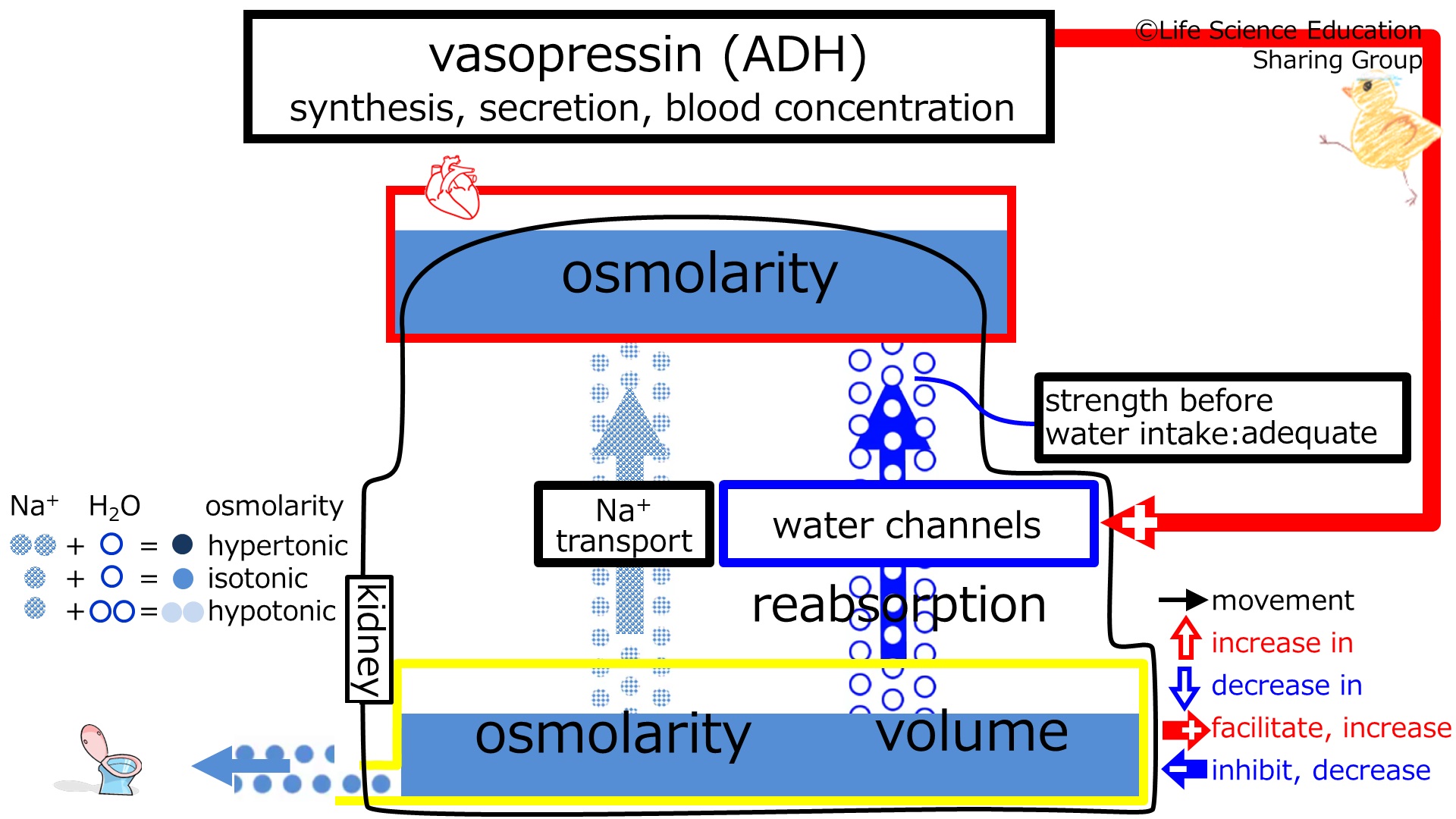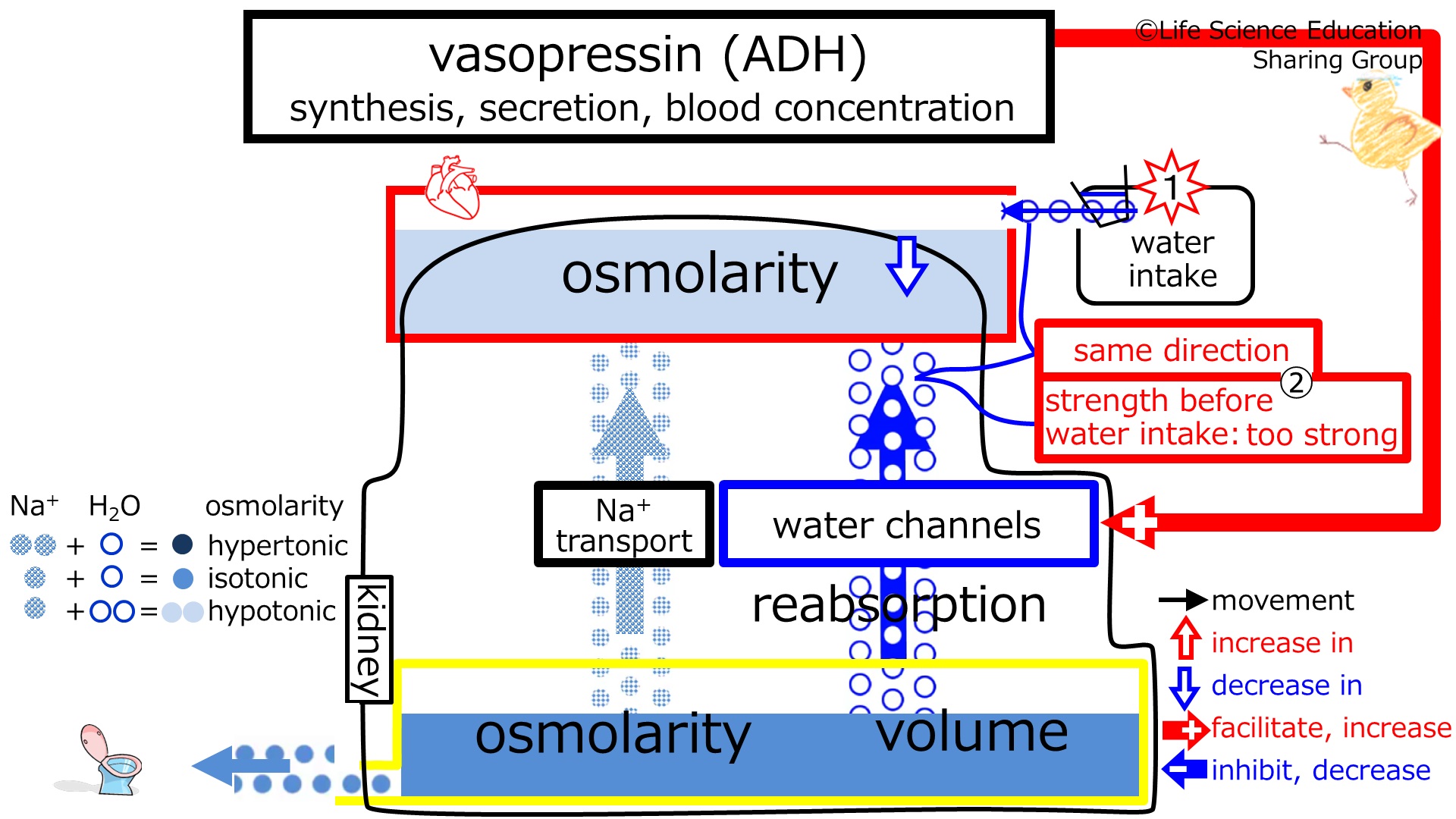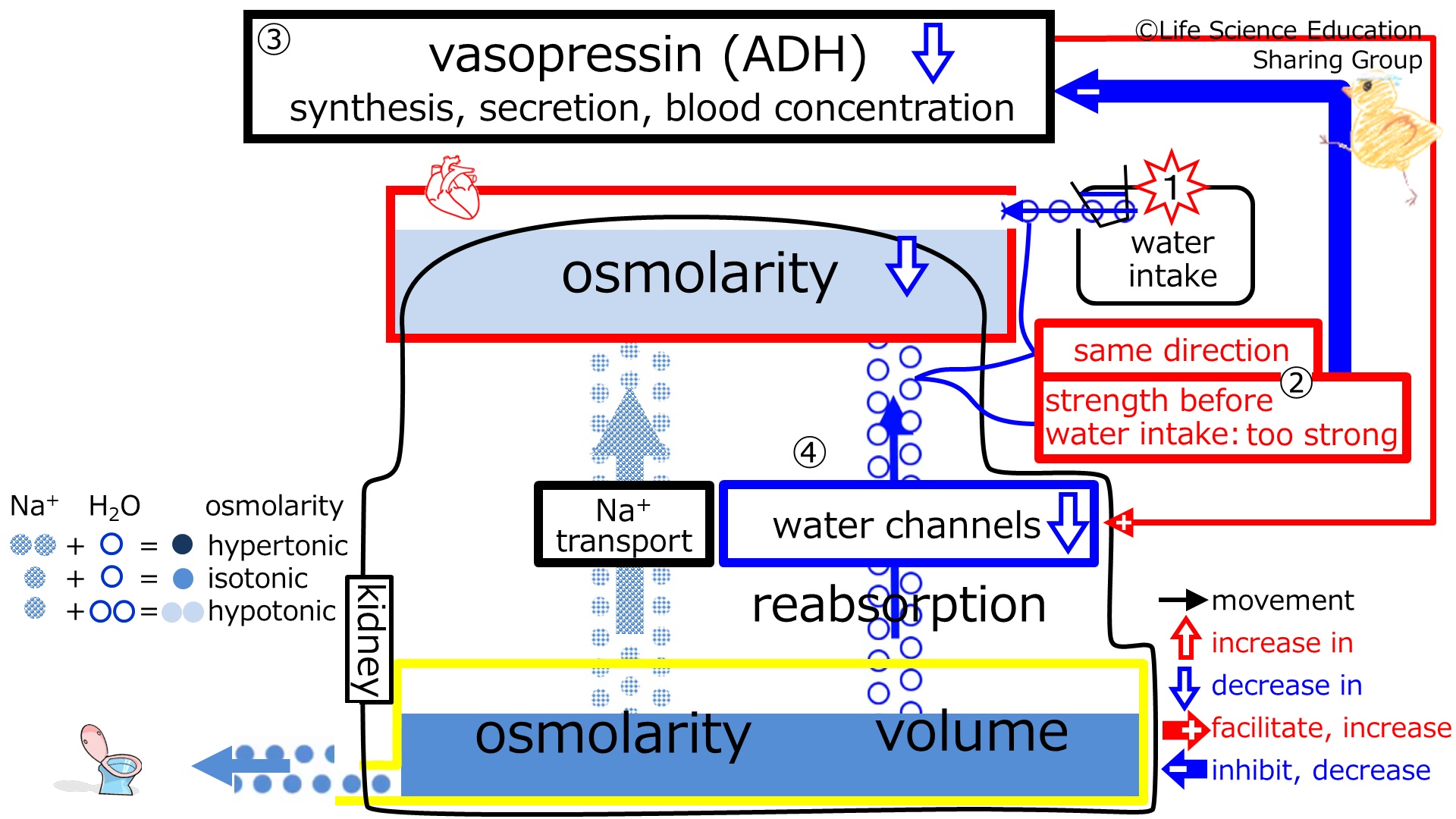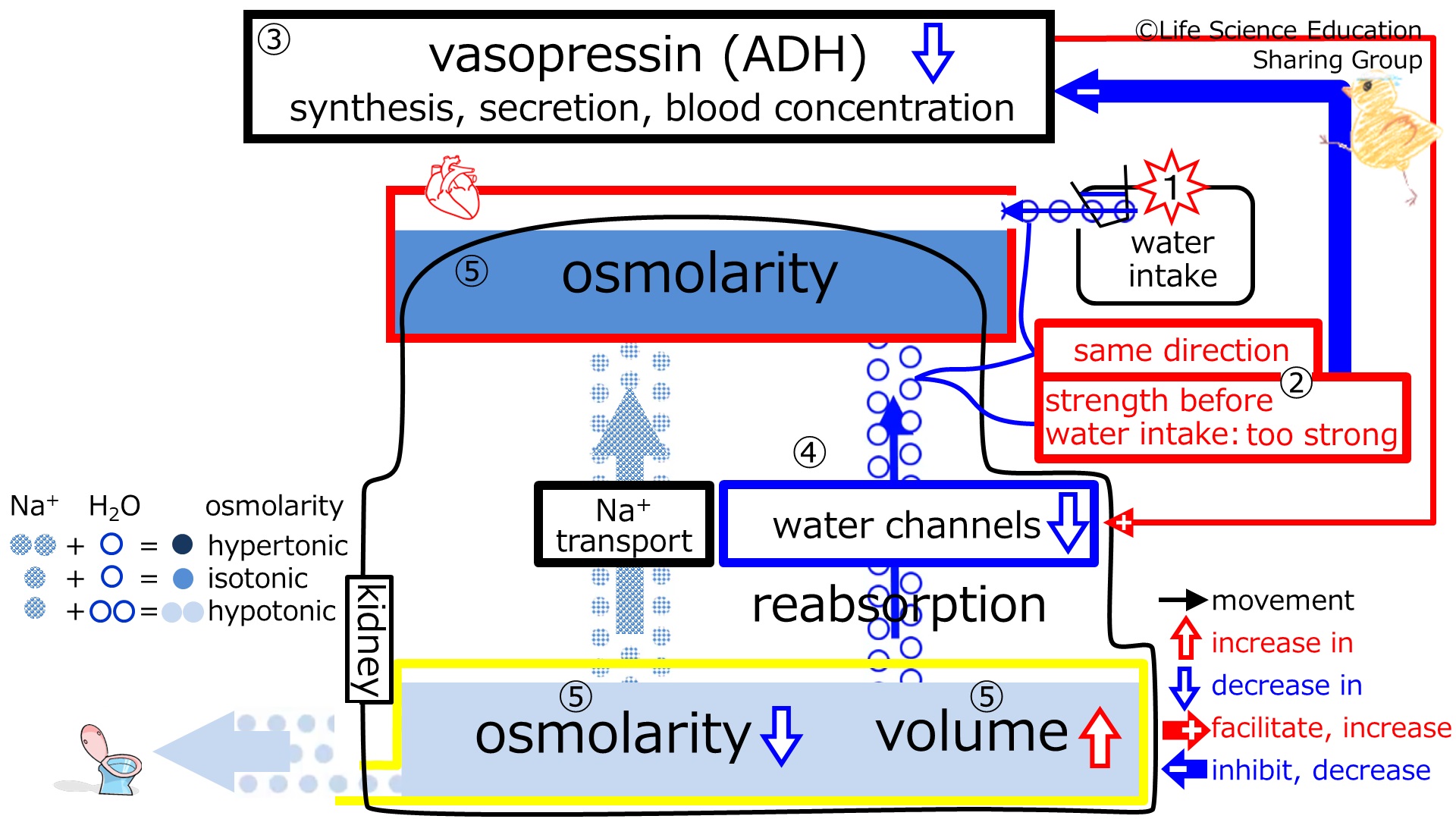「Endocrinology/VasopressinADH/ControlToWaterIntake」の版間の差分
編集の要約なし |
編集の要約なし |
||
| 32行目: | 32行目: | ||
[[メディア:ADHwaterControl-3Eng.mp4|video just after the decrease in vasopressin (ADH) caused by negative feedback]]<br> | [[メディア:ADHwaterControl-3Eng.mp4|video just after the decrease in vasopressin (ADH) caused by negative feedback]]<br> | ||
--> | --> | ||
②-1 (illustration): Because the movement of water (<u>entering the plasma</u>) with water intake and with water reabsorption (water <u>entering the plasma</u>, through the water channels, that are increased by vasopressin, ADH) are in the <font color="#ff0000">same direction</font>, the negative feedback <font color="#ff0000">decreases</font> vasopressin (anti-diuretic hormone, ADH) synthesis, secretion, and concentration in blood.<br> | |||
②-2 (illustration): The water channel-increasing effect of vasopressin (ADH) weakens, and the number of water channels decreases.<br> | |||
②-3 (illustration): With the decrease in water channels, water reabsorption from the tubule decreases from 3 to 2 columns (illustration). | |||
<br style="clear:both;" /> | <br style="clear:both;" /> | ||
| 43行目: | 43行目: | ||
[[メディア:ADHwaterControl-4Eng.mp4|video showing the changes in plasma and urine after the decrease in the reabsorption]]<br> | [[メディア:ADHwaterControl-4Eng.mp4|video showing the changes in plasma and urine after the decrease in the reabsorption]]<br> | ||
--> | --> | ||
③(illustration): With no change in Na<sup>+</sup> reabsorption, and the decrease in water reabsorption, concentrated (hypertonic) fluid enters the plasma. Because of this control, the decreased plasma osmolarity increases (towards that before water intake, or isotonicity). Namely, the initial change (the decrease in plasma osmolarity) decreases (blue downward unfilled arrow disappears). | |||
Because concentrated (hypertonic) fluid (of 3 columns of Na<sup>+</sup> and 2 columns of water) leaves the tubule with reabsorption, the osmolarity of the fluid remaining in the tubule (urine) decreases (becomes diluted, hypotonic). Also, with the decrease in water reabsorption (water leaving the tubule), the volume of water remaining in the tubule (urine) is more. Overall, the urine becomes diluted and increases in volume. | |||
<br style="clear:both;" /> | <br style="clear:both;" /> | ||
</div> | </div> | ||
2024年2月22日 (木) 09:09時点における版
| With water intake, plasma osmolarity decreases, and negative feedback decreases vasopressin (anti-diuretic hormone, ADH) synthesis, secretion, and concentration in blood. |
Before water intake, there are 3 columns (illustration) of water reabsorption (water entering the plasma through the water channels, that are increased by vasopressin, ADH, which has certain levels of synthesis, secretion, and concentration in blood), as well as 3 columns (illustration) of Na+ reabsorption (by the Na+ pump). Plasma and urine osmolarity are normal (isotonic).
1st star (illustration): With water intake, water enters the plasma, and plasma osmolarity decreases (becomes diluted, hypotonic).
Movement of water with water intake is in the same direction as water reabsorption (water entering the plasma, through the water channels, that are increased by vasopressin, ADH).
②-1 (illustration): Because the movement of water (entering the plasma) with water intake and with water reabsorption (water entering the plasma, through the water channels, that are increased by vasopressin, ADH) are in the same direction, the negative feedback decreases vasopressin (anti-diuretic hormone, ADH) synthesis, secretion, and concentration in blood.
②-2 (illustration): The water channel-increasing effect of vasopressin (ADH) weakens, and the number of water channels decreases.
②-3 (illustration): With the decrease in water channels, water reabsorption from the tubule decreases from 3 to 2 columns (illustration).
③(illustration): With no change in Na+ reabsorption, and the decrease in water reabsorption, concentrated (hypertonic) fluid enters the plasma. Because of this control, the decreased plasma osmolarity increases (towards that before water intake, or isotonicity). Namely, the initial change (the decrease in plasma osmolarity) decreases (blue downward unfilled arrow disappears).
Because concentrated (hypertonic) fluid (of 3 columns of Na+ and 2 columns of water) leaves the tubule with reabsorption, the osmolarity of the fluid remaining in the tubule (urine) decreases (becomes diluted, hypotonic). Also, with the decrease in water reabsorption (water leaving the tubule), the volume of water remaining in the tubule (urine) is more. Overall, the urine becomes diluted and increases in volume.
Challenge Quiz
With water intake, the plasma osmolarity decreases, and negative feedback increases decreases the synthesis, secretion, and blood concentration of vasopressin (anti-diuretic hormone, ADH).
With water intake, the plasma osmolarity increases decreases . This is in the same direction as opposite direction to the plasma osmolarity-increasing osmolarity-decreasing effect of the water reabsorption from the tubule (through the water channels, which are increased by vasopressin, ADH). The negative feedback increases decreases (the synthesis, secretion, and blood concentration of) vasopressin (ADH). This will increase decrease plasma osmolarity (towards isotonic).
With water intake, water enters leaves the plasma and osmolarity increases decreases . This is in the same direction as opposite direction to the plasma osmolarity-decreasing effect of the water reabsorption (through the water channels, which are increased by vasopressin, ADH). Thus, although the strength of the plasma osmolarity-decreasing effect of water reabsorption (through the water channels, which are increased by vasopressin, ADH) was too strong adequate too weak before water intake (at baseline), this strength is now too strong adequate too weak to reverse the increased decreased plasma osmolarity produced by water intake. The negative feedback increases decreases (the synthesis, secretion, and blood concentration of) vasopressin (ADH). The water channel-increasing effect of vasopressin (ADH) becomes stronger weaker , which increases decreases the number of water channels. With the increases decrease in water reabsorption from the tubule, concentrated diluted solution enters the plasma. This will lead to a reverse in the increased decreased plasma osmolarity from water intake, increasing decreasing it towards separate from normal osmolarity. Because concentrated diluted solution leaves the tubule due to reabsorption, the fluid remaining in the tubule has an increased a decreased osmolarity. Also, with the increase decrease in water reabsorption, there is more less water remaining in the tubule. Overall, the urine becomes concentrated diluted and increases decreases in volume.




